Times they are a changin’. Long a holdout against quarter-liter twins, Suzuki has released the GSX250R… just in time to be the smallest-displacement sporting twin on the market. While Kawasaki’s Ninja and Yamaha’s R3 forge ahead to 300 (or 296cc and 321cc respectively), Suzuki decided to stand pat with a 248cc twin. But, in bucking the trend of improving small displacement bikes by making them bigger, Suzuki decided to think smarter and more efficiently.
Unlike older riders, millennials are unlikely to be defined by a single passion. A bike needs to be affordable, and to perform more than one mission. It’s also not necessarily going to be outgrown. We’re reminded by Suzuki staff that this motorcycle is an apex model in some markets, despite being decidedly entry-level here.
Seating position is fairly neutral and upright, and (shockingly) fits a larger rider. Scope out our pictures, I’m 6’0” and I don’t look like a monkey making love to a football. A narrow cross section and 31” seat height should make it accessible for shorter riders as well. Suzuki claims that this is especially important, since you will lose some new riders at ‘first sit’ if they can’t reach comfortably on the showroom floor.
Other nice, practical, touches include slanted mirrors so you can see past your elbows, and a separate passenger seat with storage, helmet locks and a more relaxed passenger riding position than you might expect on a machine in this size.
People who like tinkering with their rides will love this machine. The GSX has a programmable shift light, as well as a maintenance reminder on the digital dash. Either one is settable by either the dealer or the owner. Simple screw and nut valve adjustment, doesn’t require much in the way of special tools or knowledge, and oil changes are said to be a snap. Even if you’re not a garage mechanic, low maintenance and cost of ownership was a focus for Suzuki on this project.
Great pains were taken to create a direct linkage to the supersport bikes Suzuki is famous for. Despite rocking a tubular steel frame, the bodywork is designed to make it look like a high-performance twin spar. It doesn’t end there, with an LED taillight that looks suspiciously like the one on the Gixxer 1000.
Despite these high-performance intimations, Suzuki insists this bike is a successor to the Katana line of practical, fun sportbikes. Not on the bleeding edge of performance, but able to tackle several roles at once. Suzuki reps hinted that this model may lose its alphabet soup moniker in the future (in favor of Katana), as more casual riders have trouble remembering unpronounceable strings of characters.
For our brief test of the GSX, we headed into the winding roads, epic coastal views, and low speed limits of the Palos Verdes Peninsula. The well-heeled keep their police forces on alert for hooligans tearing up their suburban streets, so we were well advised to take it easy. Even so, it was enough to get a gauge of the bike’s character.
Despite Suzuki’s claims that it’s tuned for torque, it’s not quick off the bottom, it merely gets out of it’s own way. That said, it’s exceedingly easy to ease the clutch out and engage the motor in a non-threatening way; perfect for new riders. It very predictably feeds in additional power as the revs climb, pulling strongly from 6500 rpm, and even stronger past 8000 all the way to its 10,500 redline.
The clutch engagement is predictable, while the transmission lightly and positively clicks through the gears. My only quibble is that neutral is not super-easy to find, sometimes taking more than one stab at the lever. The cockpit display is easy to read, while displaying a ton of information.
Sitting astride the 250R, the cockpit is roomy, but comfort is slightly hampered by a rider seat that slants excessively forward, requiring larger riders to take some effort to not be up against the tank, in the narrow part of the seat. Other than that, the generous space allows the rider to move around and be involved with riding the motorcycle (just like a good sportbike should), and the seat has more than enough padding for even a 200 lb rider; not a given on a 250.
The brakes are adequate to the task, slowing the lightweight motorcycle quickly and predictably, but it’s not going to put it on it’s nose no matter how hard you squeeze the conventional master cylinder and the single two-piston caliper. I didn’t get to really test how the full-sized fairing manages windflow at highway speed, or how the GSX corners at the limit of traction. That will come with our full test.
Suzuki’s claims of this being a keeper, not just a stepping stone will go untested, but the level of fit and finish and technology are definitely more appropriate to a bike well beyond it’s $4499 price tag (for reference, the Yamaha R3 and Kawasaki Ninja 300, non-ABS models, start at $500 higher … $4999). Bottom line … in its primary mission of appealing to new and budget riders, it’s a hell of a motorcycle.
Just a decade ago the only road-going Suzuki under 400cc was a dual sport, but modern reality has dictated a shift in strategy. At the launch, the GSX250R was displayed alongside a trio of other sub-250cc mounts. Suzuki insists this is the new reality . . . this is where it’s going. They may be a touch late to the party, but are embracing it.
In the end, Suzuki assures us that no matter how much is changing they’re still the brand that will continue to make bikes that compete at the highest levels (the RMs and GSX-Rs aren’t going anywhere), and blow people’s minds (Hayabusa, B-King), they’re just adding some options for the new kids at the table. They hope the GSX250R is not simply an entry level bike, but an affordable, fun keeper, as well.
See more of MD’s great photography:
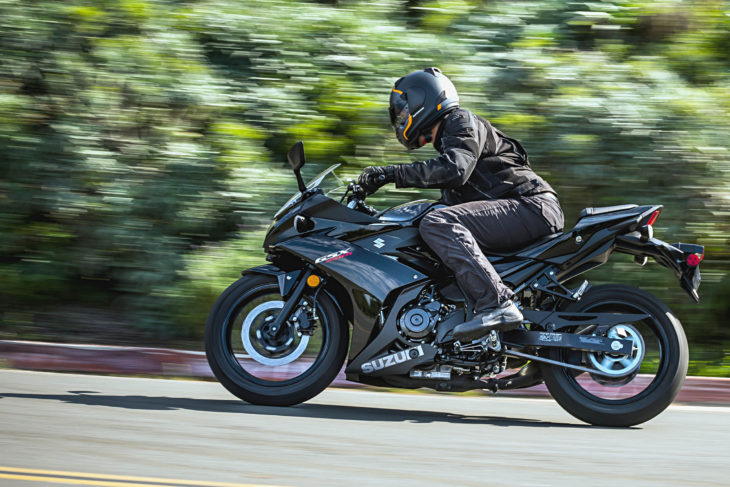
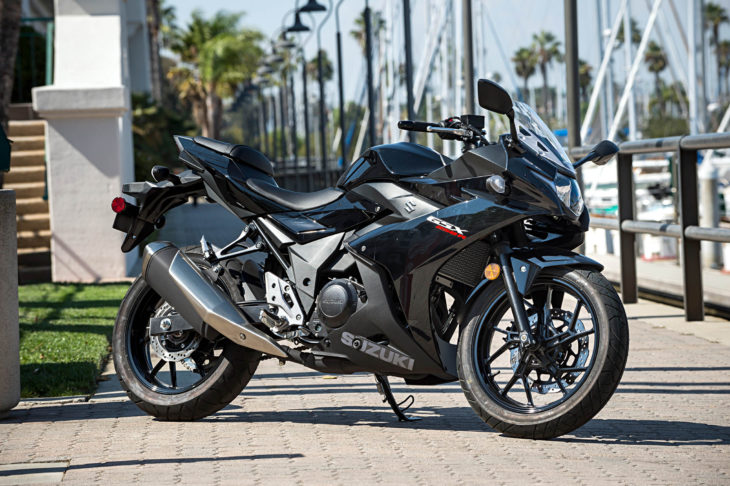
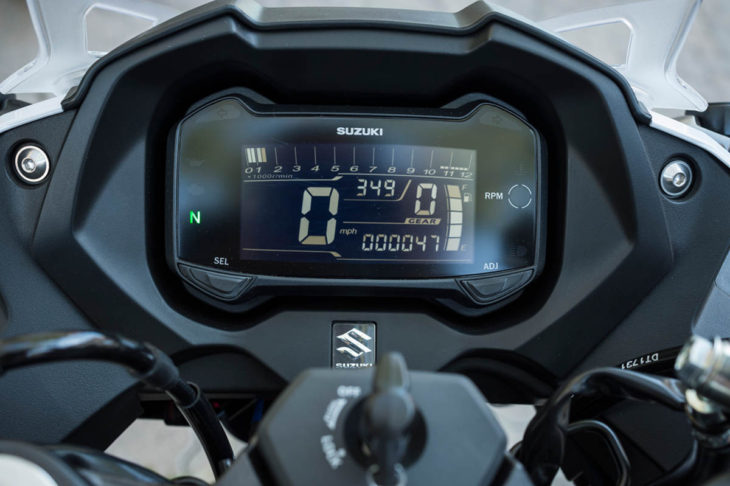
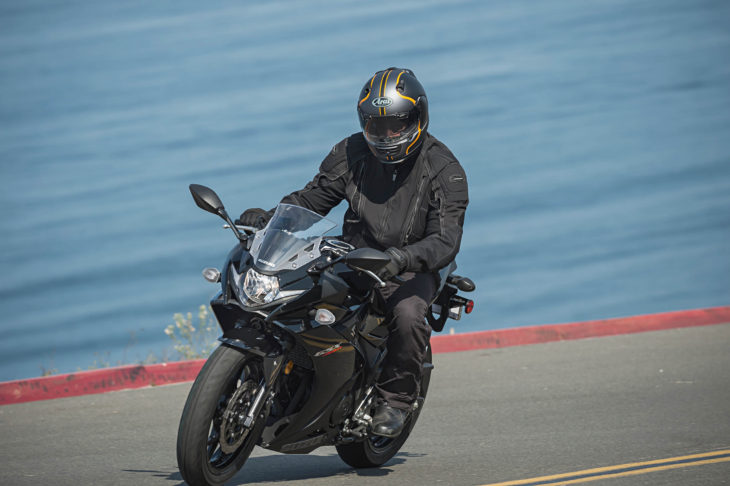
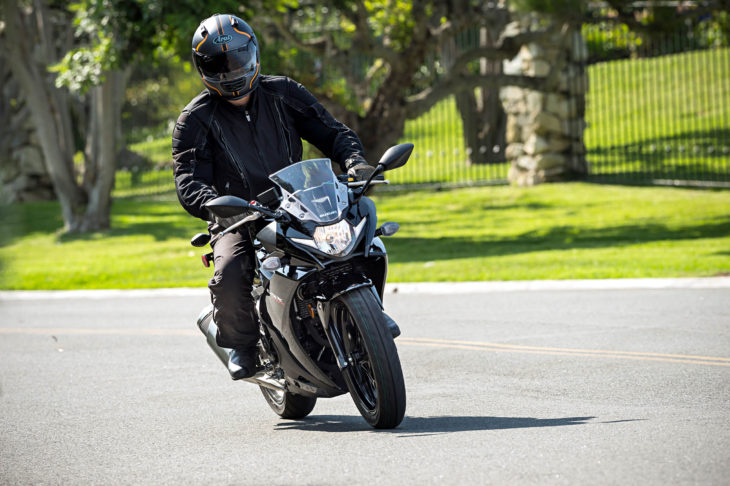






In 1992 I was freshly divorced and desperately dirt poor. Lost my car in the proceedings, so a riding friend said “Hey, look at a bike instead.” I did, and found the fairly new at the time 600cc Seca II. It was value priced at four grand, and was marketed as a beginner bike. I learned to ride on that machine in my driveway, and proceeded to ride four sets of tires off it. It was mechanically bone simple (air cooled, maintenance was a one wrench deal,) quick without being scary, comfortable as hell (6’2″ and at the time, 240#) and it was CHEAP. I still regret letting that bike go, but totaled is totaled. Entry level bikes, no matter the nit picking statistics, are needed. Way to go Suzuki for finally joining the effort.
They shouldn’t consider calling this a Katana. Let that be a 750. Not even a Shuriken… A 600. Not even a Tanto… A 400. What’s the Japanese word for pocket knife?
Too little, too late.
Or you could just buy the KTM Duke 390 for 5299$, 43 horsepower, 360lbs wet, ABS, etc.
Problems with the KTM 390 are numerous. Weight saving means wheels are relatively fragile, this is from owner reports. Other complaints involve oil consumption and leaks, engine stoppages out of nowhere. There are other problem areas as well.
Nothing is perfect, but the trade-off with KTM still seems to be all-around reliability. Nice package but I wouldn’t trust it, personally.
I wouldnt take a 390 further than I could walk. My 2006 KTM 300 XCW on the other hand… YGWYPF
Indian-made PoS… no thanks.
Of course, this Suzuki is made in China, IIRC…
This looks like a fine motorcycle and will only be ignored by the “it’s tooooo heavy and needs to be at least a 400” folks.
Can you pick the bike up, shoulder it and go for a walk with it? No? Then get over it. Whiners gotta whine but they don’t gotta buy. I’m not in the market for such a ride but if I were I would simply go take a look at one in person, if a test ride is offered do so, then find out what maintenance, tires and insurance costs are going to be. If all that adds up to what you are hoping for, enjoy the bike.
As wimpy and pusillanimous as some here appear to be, I am surprised they can carry their lard-ass egos around with them. Some of you are like road cyclists. Everything needs to be lighter except you and your ego driven desires.
The Ninja 250 sold fine as “just” a 250 for years. In the 80s Honda put out the 500 interceptor, Kawasaki the GPz550, Suzuki the 550E and 550ES and Yamaha the Seca 550. Whiners just had to whine after getting what they axed fo’ and the next thing you knew the bikes were on their way to 600cc (except the V4 Honda which went away and was replaced by a 600cc inline 4). Suzuki even offered the 400cc Bandit, but did the whiners buy ’em? No they did not and the Bandit 400 went the way of the Dodo.
You can’t always get what you whine for, so just get what you need and be satisfied that you have more than enough for who you are. It’s the street, people. Damn.
My Lard Ass ego is actually 6’2″ 170 lb. I started on a 250 and looked pretty comical on it. I don’t actually care about the looks, but I do care about being cramped, and I also care when a typical modern car can outrun me in acceleration (momentum vehicles are great in the twisties once speed is up but that’s not the only application unless you have a separate bike for everything).
I’ve spent a bit of time on a borrowed Ninja 250. There weren’t many cars that could pull away from it from a light – not that we were all trying. Just under “normal” motorcycle acceleration away from lights I was way ahead of most people by the time they even put their phones down, looked up and noticed the green light.
Someone needs a hug…
This lard ass likes his bikes to get out of their own way, and most other vehicles as well. Partly for safety, mostly for fun.
You’re not a new rider, and this 250 isn’t for you. So who cares what you think?
The same people that care about what you think.
re: “Can you pick the bike up, shoulder it and go for a walk with it? No? Then…”
…steroids.
hey, all the cool home run kings are doing them.
Still way too heavy for a 250
re: “A narrow cross section and 31” seat height should make it accessible for shorter riders as well.”
No, it won’t. My 5’4″ wife has a 30″ inseam. This is not a bike she would be able to flat foot. Yet again, a potentially market changing bike aimed at shorter riders won’t live up to it’s hype.
Agree with the other comments on price and market position, once the “shorter rider” market segment is removed. Who exactly is going to buy this in North America?
I have a 30″ inseam and had no problem flat-footing my last small Honda CBR that had a seat height of 30.6″. In fact, I had flex in my knees to spare. Don’t forget that the bike will settle down with the weight of the rider, plus the rider won’t be operating the bike in stocking feet, the heels and soles of a boot help that way.
With small bikes, flat-footing is also less critical. These bikes can be easily held upright on the forward part of the foot/boot.
With my 30″ inseam I also rode a XR650L, a bike with a seat height of 37″. It was certainly not a flat-footer, I had to balance the bike on my toes, but no problem. That bike was easy to keep upright. When coming to a full stop on uneven pavement or while off-roading I simply slid my butt to the side that had the least distance to reach and put that foot down as required.
Anyway, best to let her try sitting on the bike before declaring it as not a possibility. You may be surprised.
Japanese factories (and riders) are very attentive to ride height. There’s a famous Japanese female bike reviewer that includes foot pictures in every report to show if you can flat-foot or not. We (I’m half Japanese) aren’t usually very tall so that’s part of the reason this is not often overlooked in most of the big four offerings.
I wish I had a 30″ inseam. How in the heck does someone 5’4 get a 30″ inseam? She must be all legs lol.
I don’t need to flat foot, but I do appreciare a toe touching on each side. Anything over a 31″ seat height gets iffy for me. That eliminates a lot of cool motorcycles.
Nice loking bike imo. I could ride this bike, except I have no interest in tiddler mototcycles since 1973 .
re: “She must be all legs”
and with that we segue into ZZ… (cue Longbeards)
https://tinyurl.com/p4dqb2j
My current ride is my third-in-a-row Honda Helix CN250. This one was 15 years old with 6,000 two owner garage-kept miles on it, when I got it for $1300. My insurance from Markel is $50 a year, and at 70 mpg this thing is cheap to run. I ride solo, and it will cruise all day at 65 mph, and that’s now enough for me personally. Decades ago I bought three brand new motorcycles in a row: a Harley, a Honda, and a BMW airhead (and I wish I had kept the BMW). Anyway, since then I have only bought used. They’re generally much cheaper. Having sold cars for years, I understand vehicle depreciation. There have been very few bikes in recent years that I’m so wild about that I would rush out and buy any one of them new – and I won’t – but that’s just me.
It appears you get just what you need to be happily satisfied. Well said.
This will kill in other markets, but like most here, I’d love to see it with a 400cc twin. And 20 lbs. lighter. If it could fly that would be great too.
If you want a bike that is cheap and a good first bike, don’t buy new. A first bike you are much more likely to drop so get something used. If you want cheap get a used bike for less then this you can get a used bike. If you want cheap don’t get a sport bike the insurance will suck especially if you are young, you will spend more insuring it for 5 years then you will paying for it. I know many may not prefer touring bikes but find a bike that comes factory with bags and a windshield and take them off they often are much cheaper to insure (my experience is with MI so yours may vary). This means that you can get a used bike and throw on some crash guards and insure it for similar to what you would pay for a 250, it may even come with saddle bags meaning you can save that expense as well.
Claim this is a good bike is great but saying it is a good way to start and pretending used don’t exist is being actively ignorant.
While your point may be valid, it’s not really reasonable to expect a motorcycle publication to end every article with “you should buy used”. New motorcycle sales make for good used motorcycle sales down the road!
re: “Suzuki decided to stand pat with a 248cc twin.”
it’s a looker but good luck with that.
re: “in bucking the trend of improving small displacement bikes by making them bigger, Suzuki decided to think smarter and more efficiently.”
sorry, no business case. 99.9% dealers are multi line and this price point gets the hell comparison shopped out of it. i’m afraid this is a non-starter, and this is not just ME saying this, this comes direct from a long-time friend and even longer-time, award winning powersports sales person. they had to “hip me to the jive”.
re: “Suzuki insists this is the new reality . . . this is where it’s going.”
right then better stop for fuel, cause there’s a fair bit more miles to go (on this model at least) before reaching your destination.
Spot on Norm. I think Suzuki’s marketing department were doing there best spin job when they came up with “thinking smarter and more efficiently”
The bike may be successful in Asian countries where they are restricted to 250cc with their license.
For the North American market without any tiered licensing or taxing this bike should be a 400. If Suzuki had bored and stroked this bike to 399cc and then sold it for the same price they would have a homerun hit that they really need about now.
re: “For the North American market without any tiered licensing or taxing this bike should be a 400.”
curly, giving it to you straight since ’79.
…problem is, the N/A market isn’t interested in a 399cc engine at the same price as 600’s are. If I’m not mistaken, there are/were 400’s in Japan, but they haven’t come here since the Bandit 400 & Honda CB-1. If the catch-weight isn’t big in global markets (like 250cc is), then we only get what they offer and occasionally they’ll do a bore job and get us Ninja 300’s and R3’s…
Not talking about an inline 4 but this same twin bored and stroked up to 400 and sold for the same price as the 250. My 82 XS400RJ Yamaha was also sold as a 250 in Japan and it weighed just about the same as this Suzuki. A 400 can be a real all around, ride on every highway, bike that a 250 can’t quite manage.
The modern 250 (like the Ninja 250) has the same 27 hp as your old XS400 and are a bit lighter. They have no problem with highways. Ride one and you’ll be impressed.
The bored & stroked 250’s you’re looking for are a 300 (Ninja) and 321cc (Yam R3) bike. They can’t get up to 400cc from 250cc architecture. Bigger cylinders = wider crankshaft = wider & stronger crank case = completely different engine & bike. Plus, why would they make something more and charge no more for it?
Perhaps the KTM 390 is closer to what you’re looking for, but I’d suggest any of the 650 standards are better all around bikes. The SV650, Ninja 650 and Yamaha FZ07 are all pretty light weight. These are the platforms that a 400-450cc twin would realistically have to be made from and they’d be no lighter weight for it in the end, just slower..
Edit: As suggested below, it sounds like Kawasaki might be answering your request with a Ninja 400, that was spotted in video shoots in Milwaukee, Wi., of all places. Still not sure what’s driving the speculation that this is a 400 and not just a new 300, but there it is…
Kawasaki makes a 400 Ninja (since 2011 maybe?) for other markets, but it is a sleeved down Ninja 650 if I am not mistaken. Same weight, much less power.
Yup, learned more about that while investigating the new Ninja 400 rumor. Sounds just like you describe.
I wish motorcycling could get away from prioritizing engine displacement. The CB500r/f really ticks most of the boxes but I think it’s getting overlooked simply because it says “500” on it.
“I wish motorcycling could get away from prioritizing engine displacement.”
What would you have them prioritize exactly?
I also think the Honda 500s are excellent machines. Very beginner friendly while still having all the power one needs and more full-size ergonomics.
Well i have the old Kawasaki EX250F and still love it for its lightweight. What i really want to replace it is a modern 400-450cc Twin that puts out between 40-45kw and weights less that 370lbs. ideally a 270 crank as a bonus. Hope to find more about the Ninja 400 when its released.
Finally
392 pound curb weight ruins it. The R3 and Ninja 300 are both lighter and the original 250 ninja from 1986!! was 350 pounds full of gas. Why does this Suzuki have to be so heavy? Long live the legend of the EX250R Ninja:)
Monkey/football – I still await a full-sized 400 personally. With pictured rider it looks 7/8 instead of 3/4, I’ll give you that, but it still looks small.
Yeah, have to second both points, 400cc + proportions w/rider aboard. (I like smaller bikes, but this Suzuki test rider is small next to me.)
This is another looker, possibly the best of the US entry level race replicas. The smaller the bike, the better it tends to look. I presume that the smaller the bike, the less area the motor displaces as a ratio of the bike’s outer dimensions, thus increasing the designer’s freedom of expression. The larger the bike, the more likely the motor and/or it’s appendages occupy space otherwise employed in cosmetic design.
I suppose the ratio of bike to wheels/tires also affects design appearance. Sport bike size follows tire width, while diameter stays constant @ 17 inches. Wider tires may look more “macho,” but they may draw the eye away from the bike’s otherwise flattering lines. Ditto exhaust size.
Admittedly though, starting with the latest R1, all four Japanese open class race replicas have improved cosmetic design. They seem to have crossed from decidedly unattractive to acceptable or even favorable.
In the late 80s through the 90s, the world enjoyed numerous fantastic small-mid sized Japanese multi-cylinder race replicas not exported to the USA. I truly wish they’d make and send over some awesome 400-500cc modern race replicas. Honestly, I think they’d sell well considering the potential performance, braking, cornering, and even acceleration wise.
Okay, in that first pic, you’re right, you don’t look like a monkey humping a football. In the final pic, though?
GIT ‘R DONE!
LOL
Remember when the CB350 ruled the roads? EVERYBODY looked big on one of those…
I wonder if Yamaha had gone just a little bigger than 321 and called it a 350 if they wouldn’t have done better. They would have been the only 350.
And a naked version – the RD350. nice.
Don’t forget the CB350 was only 326cc but they called it a 350. Marketing labels can mean a lot.